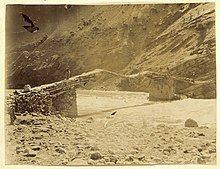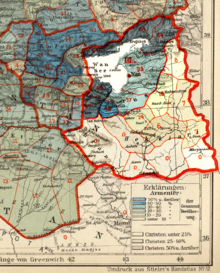Hakkari (historical region)
The region stretching from Tur Abdin to Hakkari formed the Nairi lands which served as the northern Assyrian frontier and border with their Urartian rivals.
[3][4] Following the devastation of the urban centres of Mesopotamia at the hands of Timur, a Turkic military leader operating under the guise of restoring the Mongol Empire, he was known as "the Sword of Islam."
This region also produced many bishops and patriarchs as hereditary succession was used to prevent a full ecclesiastical collapse of the church.
The Ottomans, seeking to consolidate their control of the region, engaged him in a costly war which eventually led to the dissolution of his Emirate.
[9] After the fall of his main rival Badr Khan of Bohtan sought to extend his dominion by annexing the Assyrian regions in Hakkari.
Badr Khan allied with Nur Allah and attacked the Assyrians of Hakkari in the summer of 1843 massacring them and taking those who survived as slaves.
The situation changed after the Badr Khans rule and the Tanzimat reforms as the Ottomans now were able to extend their full control unopposed, and in 1868 the Sanjak of Hakkari was created.
[17] Shimun Benjamin was able to move unnoticed to Urmia, which at the time was under Russian control, and tried to persuade them to send a relief force to the besieged Assyrians.
[17] When the Russians replied that the request was unreasonable, he returned to Hakkari and led the surviving 50,000 Assyrians through the mountains to safety in Urmia.
In 1924, after a rebellion, Turkey formally occupied northern Hakkari and expelled the last Christian inhabitants who still remained in the region,[20] with the exception of the village of Gaznakh which due to Kurdish alliances and their conversion to the Chaldean Catholic Church avoided deportation.




